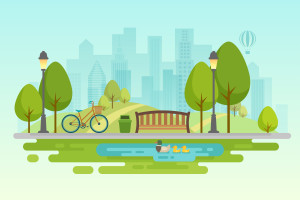 Climate change is affecting the world in a number of different ways. Today’s landscape architects are adapting to the impacts, helping to protect the built environment against the increasing numbers and intensity of extreme events.
Climate change is affecting the world in a number of different ways. Today’s landscape architects are adapting to the impacts, helping to protect the built environment against the increasing numbers and intensity of extreme events.
The American Society of Landscape Architects (ASLA) says that “global climate change presents a serious threat to humans and our environment.” A warmer climate means hotter summers and more frequent, more intense extreme weather events: wind and rainstorms, floods, and longer, hotter droughts, to name a few. Along coastlines, rising ocean levels threaten cities, farmland and natural ecosystems.
Hotter temperatures also intensify the urban heat island effect. Less green cover, and ground covered by concrete and asphalt rather than plants, raise the temperature in a city as much as 10 degrees Fahrenheit compared to surrounding rural areas. This can harm human health, and has even led to death in extreme heat waves in the past.
Climate change means we all must adapt, and landscape architects don’t get a free pass. Here are some of the ways that smart landscape architecture can adapt to climate change.
Water management
Science shows us that higher average temperatures change the hydrological cycle: faster evaporation, less precipitation, changes in customary patterns and in intensity. In the interior of the country, we can expect longer droughts and slower recharge of aquifers. It can also mean more intense rain run-off with more potential damage.
For landscape architects, we need to look for higher water efficiency. In areas prone to greater droughts, we can design to encourage rainwater to penetrate into the ground and aquifer, instead of running off to drainage. We can look at elements like permeable pavers, gardens, bioswales and constructed wetlands.
Droughts punctuated by extreme rainfall often lead to landslides, especially in mountainous regions. Good choice of trees and other plants can help stabilize slopes and reduce erosion. Other ground cover choices, such as particular soils or geotextiles, can also help.
Urban planners, civil engineers and landscape architects need to work closely to design sites that can effectively channel more frequent and larger floods. Swales, trenches, green spaces, constructed wetlands and other features will be more important in a warmer environment.
Mitigating fire risk
The costs associated with wildfire protection and suppression have tripled in the U.S. since 1990, now exceeding $3 billion per year. That doesn’t even take into account the damage to buildings and other structures.
Landscape architects can be effective in creating natural defenses from wildfire, working with planners, foresters and arborists when planning new urban developments.
Taking advantage of change
Higher average temperatures, longer periods of clear skies and stronger, more consistent wind require changes to the way we build, but they can also present opportunities for generating renewable energy.
Reduce heat islands
The urban heat island effect is well understood, and can be mitigated by landscape architecture. Rooftop gardens, open space, urban trees, lighter colored pavement materials, fountains and other elements are beautiful but also effective in providing cooler microclimates, reducing carbon emissions and removing particulates from the atmosphere.
Urban planning and landscape architecture can also work hand-in-hand to mitigate the urban heat island effect and make a more sustainable and enjoyable built environment, by planning residential areas in walking distance to commercial and industrial space, connected by walkways and cycling paths, landscaped with urban trees and other plants.
Reused and recycled materials
Landscape architects can make a great difference in creating a sustainable built environment in the choices of materials. In the U.S., construction waste accounts for up to 40% of all consumer waste created every year, and less than a third of it gets recycled.
For example, panels and beams can be made from wood trimmings and chips that are otherwise wasted. Reclaimed asphalt, excavated from old roads and parking lots is also known as recycled asphalt pavement, or RAP. It’s used widely as a cost-efficient sub-base material. Reclaimed concrete can be used in patios. Reclaimed and recycled glass has been used for ages in aggregates and as a component in asphalt and concrete, and in backfill for trenches and foundations.
Local sourcing
Choosing new materials from sources as close to the site as possible can help reduce transport costs as well as the environmental impact of transportation.
Local sources for soils, aggregates, fills and plants also mean they’re better integrated into the local environment, cause less disruption to the ecosystem and are less costly to maintain.
Mutual reinforcement
One advantage for landscape architects is that the different adaptations to climate change are mutually reinforcing. For example, increasing urban green space, through more parks, roof gardens and constructed wetlands, help reduce surface water runoff, mitigates the heat island effect and reduces carbon emissions at the same time.
Walking and cycling paths also reduce the heat island effect and emissions of not only carbon, but also atmospheric particulates that affect health.
Landscape architecture is all about adapting buildings to the ever-changing natural environment. Climate change is making us rethink some of the choices we made in the past.
At McNeil Engineering, we make it a point to stay at the forefront of our field. Take a look at some of our landscape architecture projects that anticipate and protect against droughts, floods and other extreme events.








